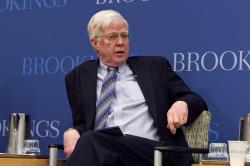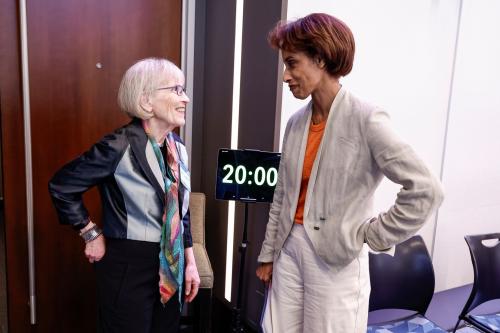ABSTRACT
The objective of this paper is to explore how the external balance of the United States might evolve in future years as the economy emerges from the recession. We examine the issue both from the domestic perspective of the saving and investment balance and from the external side in terms of the basic determinants of exports and imports and the role of the real exchange rate. We highlight the need for sustained depreciation of the dollar to improve the competitiveness of U.S. exports and argue that the current real exchange rate is consistent with a significant reduction in the size of the trade deficit to 3-4 percent of GDP. However, the favorable external outlook is very inconsistent with a projected domestic situation of low rates of private saving and a very large public sector budget deficit matched by a cyclically depressed rate of investment. A recovery of investment is likely to be accompanied by a widening of the current account deficit.
INTRODUCTION
The United States has had a substantial current account deficit ever since the early 1990s. For most of that period, the deficit has increased steadily, reaching a peak of $800 billion or 6.7 percent of national income in 2006. There has been widespread agreement that deficits of that magnitude could not be sustained and thus a pervasive fear that the economy might be heading toward a hard landing–with an abrupt collapse of the dollar and severe economic disruptions both domestically and globally.
In the fully-employed economy of the mid-decade, the rebalancing of the U.S. economy was viewed as a relatively straight-forward, though politically-difficult twopronged task. It would require: (1) changing the composition of domestic demand away from an over-emphasis on domestic consumption in order to free up resources for increased production in the tradable-goods sector, and (2) expenditure-switching aimed at directing those resources into increased exports. The first goal was often described as a need to increase national saving, and the second as a change in the relative price of U.S.-produced products to make them more competitive in world markets.
For a brief period in the middle of the decade, it appeared that a relatively benign adjustment might be underway. A real depreciation of the U.S. dollar improved the competitiveness of American products and the current account deficit gradually began to recede during 2007 and the first three quarters of 2008. The improvement would have been even more marked were it not for the sharp increase in the price of petroleum imports. Export volumes grew by 18 percent between the 2nd quarter of 2006 and the 2nd quarter of 2008, while import volumes were flat. The U.S. seemed to have begun a softlanding.
However, there was little evidence of adjustment on the domestic side. The national saving rate continued to decline, turning negative in early 2008 due largely to sharply higher federal budget deficits. It was falling rates of investment, not increases in saving that freed up domestic resources. The government responded to a weakening of residential investment with a temporary tax cut aimed at stimulating consumption, further reducing saving.
All of this changed in the fall of 2008 with the onset of a global financial crisis centered on the United States. There has been a severe contraction of domestic demand and employment, and concerns about the composition of aggregate demand have largely vanished in the midst of extreme countercyclical policies aimed at stabilizing the economy. The external economy experienced an even larger collapse as global trade declined 25 percent below trend in the first half of 2009. U.S. exports fell 20 percent below year earlier levels, with imports falling an even larger 28 percent. In 2009, the U.S. current account deficit is estimated at only 3.5 percent of national income – half its value in the peak year of 2006. Perversely, the U.S. real exchange rate also soared – temporarily reversing about half of the prior decline from its peak as investors sought a safe haven in U.S. treasury securities
What will be the future of external rebalancing, and should it still be a major policy concern? The recession is ending, but most forecasts for the United States suggest a weak recovery with high levels of unemployment continuing for several years. Furthermore, distortions in the domestic saving and investment balance are far worse than before the crisis: the fiscal deficit has pushed the national saving rate highly negative and the rate of net investment is a third that of the pre-crisis years. In other countries that experienced severe financial crises, recovery was largely driven by improvements in the trade balance (export-led growth). However, such a scenario may be difficult in a global recession where most countries will see increased exports as a solution to their problems. Will the recovery of trade flows leave the United States with an imbalance comparable to that of the pre-crisis years?
The objective of this paper is to explore how the U.S. economy and its external balance might progress in future years. In the next section, we review the evolution of the external imbalance over the past quarter century – both from the domestic perspective of the saving and investment balance and from the external side as reflected in the U.S. current account imbalance and international investment position. The bulk of the paper then focuses on challenges to external rebalancing from both the domestic and external perspectives. We examine the causes of low private saving in the United States and how saving might evolve in the future. Second, we highlight the challenges faced by the public sector as the result of the aging of the population and continued rapid growth of health care costs. On the external side, we summarize the recent research on the determinants of trade flows and other elements of the current account. We focus particularly on the sensitivity of trade to variations in the real exchange rate and on concerns related to U.S. export performance. Finally, we pull these strands together to consider the risks to a resumption of the soft-landing that the crisis has arrested.



